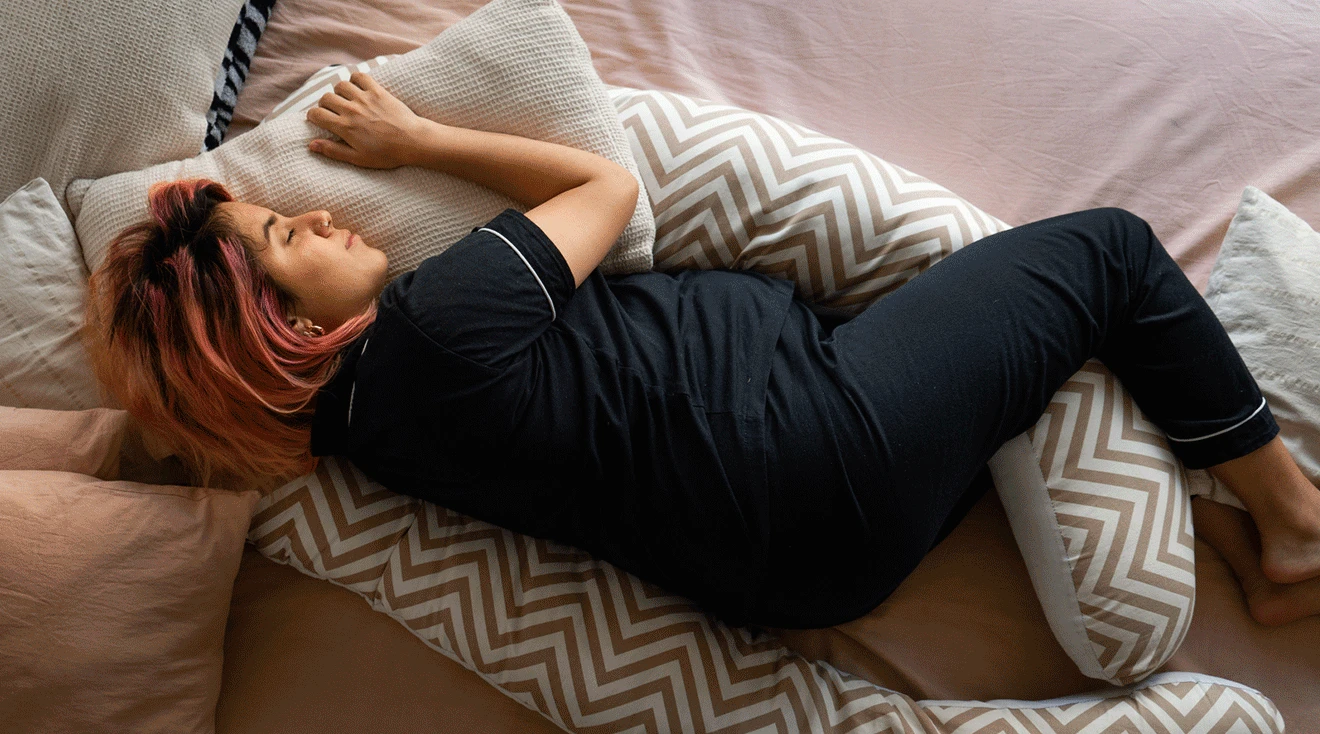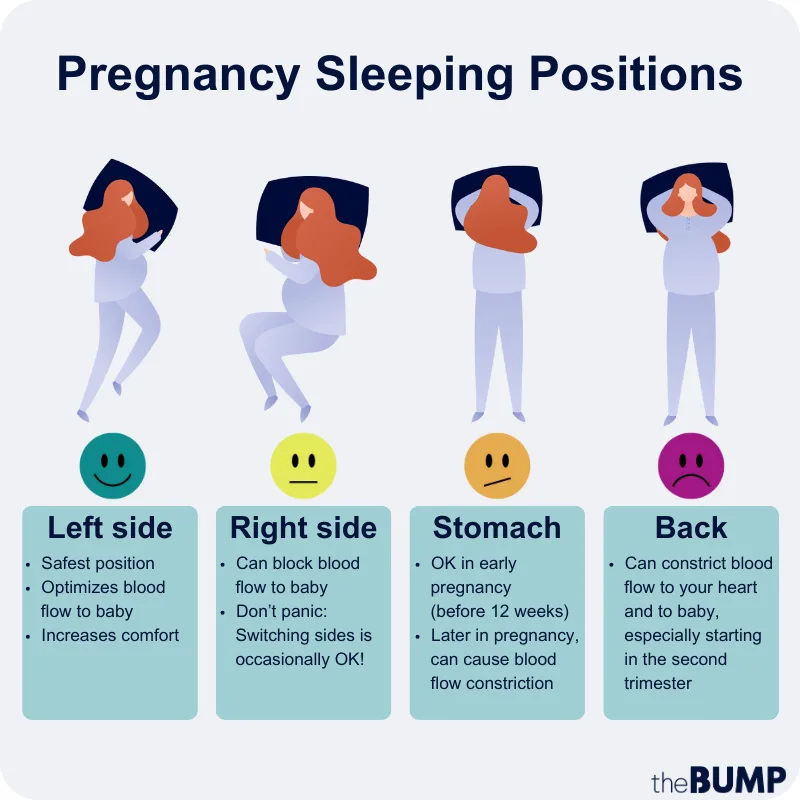These Are the Safest Pregnancy Sleeping Positions
Depending on how you normally snooze through the night, you might have to rethink your favorite sleeping positions while pregnant. As you may already know, some pregnancy sleeping positions are better for baby than others. Plus, as your bump grows, you may find some of your go-tos increasingly uncomfortable. The good news? You likely won’t have to switch things up until you hit the second trimester and really start showing. Keep reading to learn more about what you need to know about sleeping while pregnant, and how to find pregnancy sleep positions that are comfortable and safe throughout those nine+ months.
There are three main sleeping positions recognized by experts at the Sleep Foundation: on your back, stomach or side. The biggest concern with each of these, sleep experts say, is how they affect blood flow to baby and whether they compress the inferior vena cava (IVC) as your uterus grows. The IVC is a large vein that runs up the right side of your spine and carries deoxygenated blood from the lower and middle body to the heart. Below, more about each sleep position during pregnancy and how they may impact your growing baby.
Can you sleep on your side while pregnant?
Sleeping on the side is widely recognized as the best pregnancy sleep position, the Sleep Foundation agrees. More specifically, experts say, sleeping on your left side during pregnancy is safest. Wondering: Why can’t I sleep on my right side while pregnant? Sleeping on the right can cause some compression of the IVC and block blood flow to baby. Meanwhile, sleeping on the left side “gets all the weight of the uterus off the right side and optimizes blood flow,” explains Sara Twogood, MD, an ob-gyn at Cedars-Sinai Medical Center in Los Angeles. It can also help increase mom’s comfort, she adds. That said, if you’re really more comfortable sleeping on the right side during pregnancy, you can use pillows to prop up the uterus so it’s not sliding to the right, Twogood says.
Can you sleep on your back while pregnant?
While it’s touted as one of the best sleep positions for posture, sleeping on your back while pregnant is largely considered a no-no. Between 15 and 20 weeks gestation, the uterus starts becoming large enough to interfere with blood flow when you sleep on your back, as it can compress the IVC. Sleeping on your back while pregnant can also constrict the aorta—the main artery carrying blood from the heart to the rest of the body—and block off the main blood supply to your body and placenta. As a result, “Sleeping on your back can decrease the return of blood to the heart, so the mother may wake up feeling short of breath or as though her heart is racing,” says Amelia Henning, CNM, a staff midwife at Massachusetts General Hospital in Boston.
Can you sleep on your stomach while pregnant?
Sleeping on your stomach is fine in early pregnancy—but sooner or later you’ll have to turn over. “Before 12 weeks, you can sleep any way you want,” Twogood says. “A lot of women have breast tenderness or sensitivity, so many aren’t comfortable sleeping on their stomachs early on. But it’s just discomfort—it won’t cause any harm.” Henning agrees, adding that sleeping on your stomach while pregnant is okay until the belly really starts to show, usually between 16 and 18 weeks, depending on how big the belly gets and how quickly. After this point, not only does sleeping on your stomach get pretty uncomfortable, but it also becomes unsafe for baby. Sleeping on your stomach while pregnant can cause your baby bump to move inside your stomach and press against the aorta and IVC. “Sleeping flat on your stomach has the same negative effects as sleeping on your back,” Twogood explains.
It’s not at all uncommon to fall asleep in one position and wake up in a totally different one, so it makes sense that one of the biggest concerns is waking up to find you’re sleeping on your back while pregnant. But if you do wake up on your back, don’t panic. “You probably weren’t there for very long,” Henning says, since your body adjusts to avoid uncomfortable sleep positions. “If you’re on your back and in the third trimester, it will compress the blood flow and make you feel bad quickly, so you’ll wake up and wouldn’t have been lying on your back long enough to compromise the blood flow to baby.”
However, if you continue to wake up on your back (or stomach or right side) and are worried about it, ask your partner to check on you, Twogood suggests. If they wake up and notice you sleeping on your back, they can gently move you back to your left side. You should also bring up any concerns to your ob-gyn. They can help you find the optimal pregnancy sleeping positions for your individual circumstances.
It may be challenging to change the sleeping positions you’ve found comfortable, but take heart in knowing it’s possible—and your body may naturally adapt to more restful pregnancy sleeping positions as your bump grows. But if not, there are ways to train yourself to start sleeping on your left side if you don’t already. Bonus: Sleeping on your side can also help with some of the other aches and pains that are no doubt wreaking havoc on your nightly shuteye.
Get a pregnancy pillow
If you’ve been a back or tummy snoozer all your life, changing to your left side can be hard. “I fully recommend getting a pregnancy body pillow and getting it early,” Twogood says. “You want to optimize its use during pregnancy, playing with its positions and [exploring] how it can support you best.” If you still can’t comfortably make the switch to your side, use pillows to prop yourself into an incline. Sleeping on your back at a 45-degree tilt can prevent a lot of the compression.
Bend your knees
If you’re suffering from hip, leg or back pain during pregnancy, try bending your knees, ACOG says. You can also try placing a pillow under your legs, between your knees or under your belly for added support.
Practice good sleep hygiene
You may find it easier to fall asleep in a new pregnancy sleeping position if your body has already been primed for rest with good sleep hygiene. The Centers for Disease Control and Prevention (CDC) recommends limiting caffeine intake and screen time before bed; avoiding eating or drinking too late at night; keeping a regular sleep schedule; and finding ways to relax and ease stress. “Getting into a healthy ritual before going to sleep during pregnancy can ensure you consistently get a good night’s sleep,” says Sherry Ross, MD, an ob-gyn, author, and co-founder of Oneself Intimate Skin Care and the Women’s Health & Wellness School on the MprooV app. “Taking a warm bath, drinking a cup of chamomile tea and practicing relaxation techniques are helpful tools promoting a good night’s sleep.”
Go easy on yourself
If you’re uncomfortable, you may need some extra pillows—or to do some stretches—to ease your discomfort, says Christine Greves, MD, FACOG, an ob-gyn at the Winnie Palmer Hospital for Women & Babies in Orlando, MD. “Try to find comfortable positions and give yourself grace,” she says. “If you do wake up on your right side or on your back, try to reposition yourself on the left side and don’t feel guilty. Recognize that was probably the baby waking you up to say turn on your right side!”
Frequently Asked Questions
What’s the best pregnancy sleeping position?
Experts agree that sleeping on your left side is best because it helps improve blood flow to baby and avoids compression of the inferior vena cava (IVC) as your uterus grows. If you’re not doing so yet, Twogood says it’s best to start at least in the mid-to-late second trimester. And if you tend to toss and turn? “Switching between sleeping on the right and left side is fine too,” she says.
Should I be using a pregnancy pillow while sleeping during pregnancy?
It’s not a requirement, but a pregnancy pillow is a great tool if it makes you more comfortable and helps you get into the optimal pregnancy sleeping position, experts say. “Pregnancy pillows provide extra support for your growing belly, back, knees and hips, giving more comfort for a restful night’s sleep,” says Ross. She suggests placing either three individual pillows or one long pillow between your arms, under your growing belly and between your knees.
Why can’t I sleep on my right side while pregnant?
Again, sleeping on the right side can compress the IVC, which can block blood flow to baby, says Twogood. However, switching to the right side occasionally is okay, she adds.
How long can you lay on your back when pregnant?
“It depends on so many factors, like gestational age, weight and comfort,” says Twogood. “There’s no specific number of minutes that's been shown to be safe versus unsafe.” She adds that it’s typically okay to lay on your back during the first trimester, but in the mid-to-late second trimester, she recommends avoiding lying flat on your backs for prolonged periods of time. Ross suggests limiting your time on your back to one to two hours at this point: “Sleeping on your back for long periods of time can ultimately reduce the blood flow to baby, which can affect [their] growth and overall health,” she says.
Of course, a lot of this may seem easier said than done when you’re finding it hard to find a comfortable pregnancy sleeping position and can’t sleep. But don’t lose hope! Trust that your body will naturally find new pregnancy sleeping positions that feel comfortable with your growing bump. And for any questions and concerns, don’t hesitate to reach out to your ob-gyn. They’ll help you get the resources you need to start getting more restful shuteye.
Please note: The Bump and the materials and information it contains are not intended to, and do not constitute, medical or other health advice or diagnosis and should not be used as such. You should always consult with a qualified physician or health professional about your specific circumstances.
Plus, more from The Bump:
Christine Greves, MD, FACOG, is an ob-gyn at the Winnie Palmer Hospital for Women & Babies in Orlando. She received her medical degree from the University of South Florida College of Medicine.
Amelia Henning, CNM, MSN, IBCLC, is a staff nurse-midwife at Massachusetts General Hospital in Boston, the director of the Mass General Lactation Program and a teaching associate with Harvard Medical School. She earned her bachelor’s degree from Wheaton College and completed her midwifery education at the University of Pennsylvania.
Sherry Ross, MD, is an ob-gyn and women’s health expert at Providence Saint John’s Health Center in Santa Monica, California. She’s the author of She-ology: The Definitive Guide to Women’s Intimate Health. Period. and She-ology, the She-quel: Let's Continue the Conversation. She’s also the co-founder of Oneself Intimate Skin Care and the Women's Health & Wellness School on the MprooV app. She received her medical degree from New York Medical College.
Sara Twogood, MD, FACOG, is a board-certified ob-gyn at Cedars-Sinai Hospital in Los Angeles and co-founder of Female Health Education. She also the author of Ladypartsblog.com, which covers topics relating to fertility and pregnancy, and the founder of FemEd, a program designed to empower females through health education.
American Pregnancy Association, Best Sleeping Positions During Pregnancy
Sleep Foundation, Pregnancy Sleep Positions, November 2022
Sleep Foundation, Best Sleeping Positions,, October 2023
Cleveland Clinic, Vena Cava, March 2022
The American College of Obstetricians and Gynecologists, Back Pain During Pregnancy, December 2021
Centers for Disease Control and Prevention, Tips for Better Sleep, September 2022
Learn how we ensure the accuracy of our content through our editorial and medical review process.
Navigate forward to interact with the calendar and select a date. Press the question mark key to get the keyboard shortcuts for changing dates.




















































